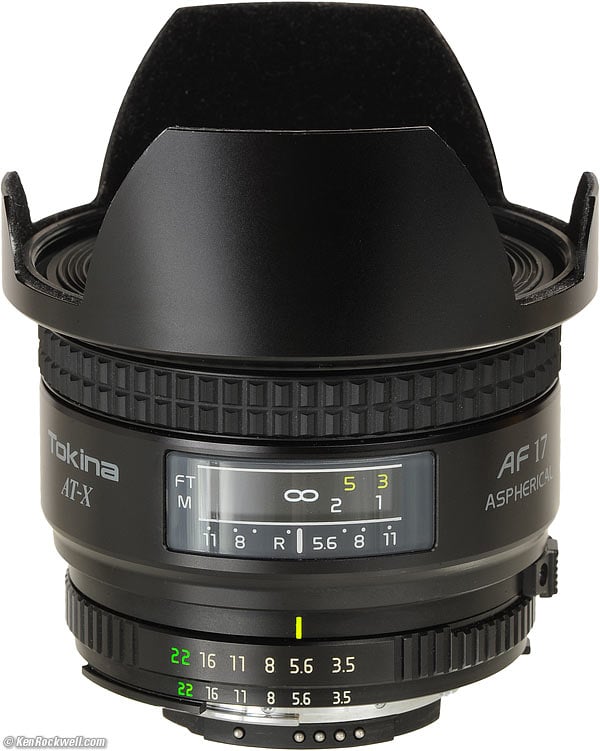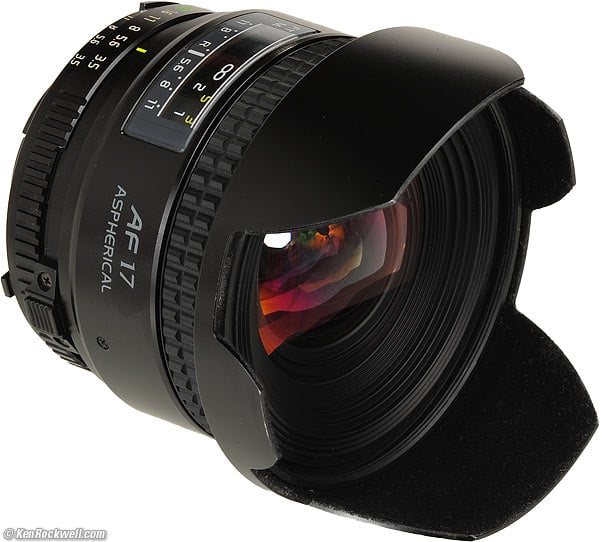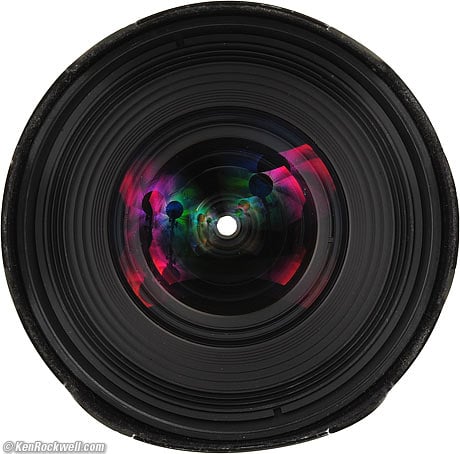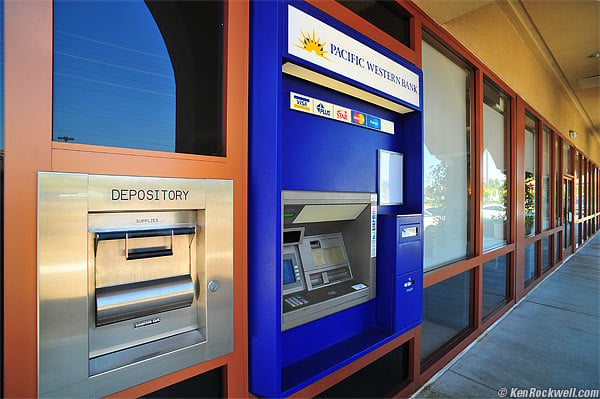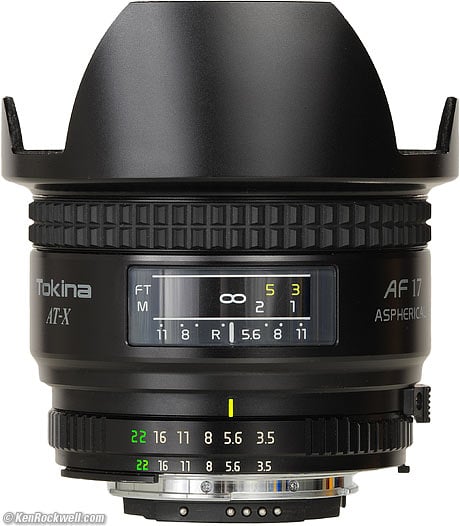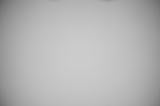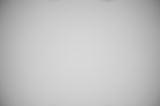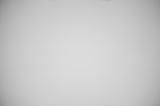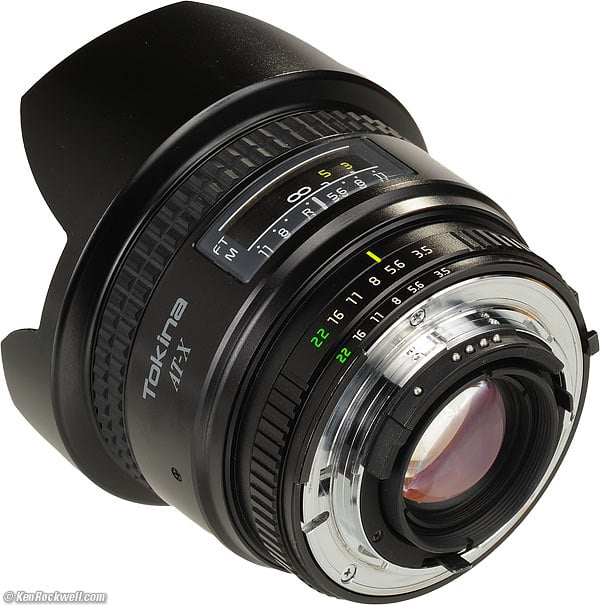Home Donate New Search Gallery How-To Books Links Workshops About Contact
Tokina 17mm f/3.5 AT-X
AF Aspherical and PRO (1993-2005)
© 2010 KenRockwell.com. All rights reserved.
Intro Specifications Performance Compared Recommendations
Tokina AT-X 17mm f/3.5 AF. enlarge. There are two versions: the first 1993-1999 version shown here, taking 72mm filters at 14.325oz./406.0g, or the PRO 1999-2005 version taking 77mm filters at 15.5oz./440g, which is not shown here. Each is about $200 used. You can get them at this link to them at eBay (see How to Win at eBay), and sometimes used at Adorama.
August 2010 Tokina Reviews Nikon Canon LEICA All Reviews
Sharpness Comparison to all other 17mm and 18mm Nikon and Tokina lenses
Manual-Focus Tokina 17mm f/3.5 SL Review
Ideal Uses
Low-price ultrawide for on FX digital and 35mm film. It came in mounts for Nikon AF, Canon EOS, Sony Alpha and Minolta Maxxum.
Not for
I wouldn't bother with this on a small-format digital camera, like Nikon DX or Canon 1.6x. Instead, I'd use any basic 18-55mm kit lens to do the same thing.
This lens will not autofocus on Nikon's cheapest D40, D40x, D60, D3000 or D5000 cameras, but everything else works fine.
| Optics: | |
| Mechanics: | |
| Ergonomics: | |
| Usefulness: | |
| Availability: | |
| Overall: |
Introduction top
Intro Specifications Performance Compared Recommendations
|
I personally buy from Adorama, Amazon, Ritz, B&H, Calumet and J&R. I can't vouch for ads below.
|
The Tokina AT-X is a very well made, optically pretty good and very low cost (as of 2010) ultrawide lens for use on full-frame and film.
It is all-metal; tougher mechanically than most camera-brand lenses.
Its weakest point is that while its optics are very sharp and contrasty at all apertures throughout 90% of the image, it very quickly gets very soft in the farthest corners of full-frame. If you worry, pay six times as much for the Nikon 16-35mm VR instead.
The Tokina 17mm f/3.5 AT-X is a full-frame ultrawide angle lens, and I will be reviewing it as such.
It is silly to waste this on a small-format camera like Nikon's DX or Canon's 1.6x cameras, on which an 18-55mm kit lens will do the same thing for less.
Camera Brands
The Tokina 17mm f/3.5 AT-X came in mounts for Nikon, Canon, Sony, and Minolta. I will be addressing the Nikon mount here. You can make the usual extrapolations for different mounts.
AT-X and AT-X PRO
The AT-X and AT-X PRO are the same lens, differing only in mechanics. They use exactly the same optics.
"PRO" has nothing to do with being a better or more professional lens; the name "PRO" was simply a way for the marketing department to herald the restyled lens as being better than the previous style.
AT-X |
AT-X PRO |
|
| Anni | 1993-1999 |
1999-2005 |
| Filter | 72mm |
77mm |
| AF/MF switch | Use camera's switch |
Focus-ring clutch |
| Diaphragm blades | 7 |
8 |
| Sunstars | 14 points |
8 points |
| Graphics Font | Unique and interesting |
Ugly |
| Weight | 406g |
440g |
| Weight | 14.3 oz. |
15.5 oz. |
| Hood | Permanently attached metal |
Plastic bayonet |
The version shown here is the earlier AT-X Aspherical version. Its optics are identical to the PRO version.
The PRO version seems bigger and tougher, yet I prefer this earlier version for its permanently-attached solid-metal hood, 7-bladed diaphragm (which begets 14-pointed sunstars) and lighter weight. The PRO version adds a very nice trick whereby you may switch between AF and manual focus simply by moving the focus ring forward or back, but has an inferior 8-bladed diaphragm (begetting only 8-ponted sunstars), dinky plastic hood, and more weight.
Your choice between them should be based on your system's filter size, your liking of 14-point versus 8-point sunstars, the focus clutch of the PRO version, and any preferences about the hood. The AT-X' 72mm filter is standard for 1970s-1980s professional Nikon and Canon lenses, while the AT-X PRO's 77mm is more standard today.
Tokina 17mm f/3.5 AT-X Aspherical (1993-1999). enlarge.
This is not a Canon, Nikon or other camera-brand lens. Therefore, there is always the potential for some feature not working at all on your particular camera, or something not exactly compatible. If you have a problem, I doubt Tokina is still updating firmware.
Specific problems I have with this sample of lens are that I need to use -1 stop exposure compensation on my Nikon D3, otherwise it overexposes. Other cameras like my D300 seem fine.
I see a large amount of autofocus error with this sample of lens with my cameras. This lens attempts to autofocus past the subject, which is rarely a problem and corrects easily with the D3's AF FINE TUNE feature. It is a problem on older autofocus Nikons without the ability to fine-tune AF, like my F6, F5 and F4, because for subjects at infinity, it attempts to focus beyond infinity, which it cannot do because the focus ring stops at infinity. This prevents focus lock in AF-S mode, which prevents AF cameras from taking a picture in that mode. On these cameras, focus manually by looking at the ground glass, and the problem is solved.
Another incompatibility is that it will not autofocus with the cheapest D40, D40x, D60, D3000 or D5000, but if you focus manually, everything else should work great. These cameras have in-finder focus confirmation dots to help you.
Everything seems fine on manual-focus Nikons, and because this lens has the correct maximum-aperture index ridges on the back, keys-in full matrix metering on the Nikon FA, which my manual-focus Tokina 17mm f3.5 SL does not.
Once we get past these potential problems on Nikon, this is an FX lens, and works especially well with on FX, film and DX Nikons like the D700, D3X, D300s. It should work fantastically on manual-focus cameras like the F2AS, F3, FE and FA, since it has a real manual-focus ring that works exactly as it should.
See Nikon Lens Compatibility for details on your camera. Read down the "AF, AF-D (screw)" column for this lens, but remember: these tables presume that everything works as well as a real Nikon lens, which this is not.
Specifications with commentary top
Intro Specifications Performance Compared Recommendations
Optics
11 elements in 9 groups.
Floating elements; the rear groups move more than the front groups when focused.
It's multicoated.
Tokina 17mm f/3.5 AT-X Aspherical (1993-1999) at f/5.6. enlarge.
1993-1999: AF Aspherical version
7 straight blades.
Stops down to f/22.
1999-2005: AF PRO version
8 straight blades, per Tokina's specifications, unconfirmed by me.
Stops down to f/22.
0.82 feet (0.25 meters).
Hard Infinity Focus Stop? specs top
Yes.
This is great for astronomy; just turn to the stop and you have fixed laboratory-perfect focus all night.
Nikon version focuses in same direction as Nikon lenses.
Yes.
Depth-of-Field Scale specs top
Yes.
Infra-Red Focus Index specs top
Yes, dot marked "R" in depth-of-field scale.
Yes.
Full-stop clicks, oddly, missing click for f/4 and instead only clicks at f/5.6.
1993-1999: AF Aspherical version
72mm, metal.
Does not rotate.
Moves in and out slightly with focus.
1999-2005: AF PRO version
77mm, metal.
May or may not move in and out with focus.
1993-1999: AF Aspherical version
80.00mm (3.150") diameter by 80.75mm (3.179") extension from flange (88.95mm (3.502") overall), measured, including fixed hood.
1999-2005: AF PRO version
Rated 88mm (3.3") diameter, 65mm (2.6") overall, excluding hood.
1993-1999: AF Aspherical version
14.325oz. (406.0g), measured.
With original period caps, measures 15.025 oz. (425.9g), carry weight.
1999-2005: AF PRO version
Rated 15.5oz. (440g) by Tokina.
1993-1999: AF Aspherical version
Solid metal, a permanent part of the metal lens barrel.
1999-2005: AF PRO version
Plastic bayonet BH773.
Japan.
Performance top
Intro Specifications Performance Compared Recommendations
Overall Focus Bokeh Distortion Ergonomics Falloff Filters
Ghosts Color Fringes Mechanics Sharpness Sunstars
Overall performance top
The Tokina 17mm f/3.5 AF is a swell lens, however with my Nikon D3 I need to set -1 stop exposure compensation and -20 AF FINE TUNE to get it to work as expected.
Once set, the images are sharp, colorful and contrasty at every aperture throughout most of the image including the sides, however the farthest corners are always soft.
Focus performance top
Warning: My sample attempts to autofocus beyond the subject, asking for some AF FINE TUNING. If ignored, or if my AF Nikon camera lacks that adjustment, autofocus will not be able to lock at infinity and the camera will not fire at infinity in AF-S mode. This is no problem on manual focus cameras or in manual-focus mode or on the newest digital cameras with AF FINE TUNING, but can be a big pain with older AF cameras.
When used on a non-adjustable AF camera, no big deal. Ignore this most of the time, and if you need to focus at infinity, simply switch to manual focus and move the focus ring to the infinity stop by feel.
AF Speed
AF is fast, as expected.
One full turn (two half-turns) of the AF screw pulls focus from infinity down to 3.5 feet.
AF Accuracy
Once tended to with AF FINE TUNE, all is perfect. You can't really mess up the focus of an ultrawide lens.
My sample of lens auto focuses beyond the intended subject on my F5, D300, F4 and F6, but the biggest problem with that is that these cameras won't lock focus and shoot if the subject is at infinity, since the infinity focus stop prevents the lens from focusing beyond infinity. On these cameras, switch to manual and set the ring to the infinity stop for perfect infinity focus.
Manual Focus
Manual focus is wonderful. It feels better and more precise than most Nikon AF lenses!
Bokeh performance top
You can't ever get much out of focus with an f/3.5 17mm lens. If you can get anything much out of focus, you are probably doing something deliberately crazy, for which this 17mm lens' odd-looking bokeh may actually help express your point even better.
Gauged by traditional standards, out-of-focus backgrounds tend to be distracting, with blur circles becoming circular and ovoid rings as opposed to flat discs or soft blobs.
Distortion performance top
The Tokina 17mm f/3.5 AF has a somewhat bloated center, while straight lines near and parallel to the edges tend to remain straight.
For almost any normal use, like this shot below, it's invisible.
Bank, no distortion correction. bigger.
This can be improved for critical use by plugging these figures into Photoshop's lens distortion filter, however waviness will remain and the center will be differently distorted than the sides. These aren't facts or specifications, they are the results of my research that requires hours of photography and calculations on the resulting data.
FX and Film |
||
30' (10m) |
+1.5 |
|
10' (3m) |
+1.0 |
+2.2 |
3' (1m) |
+1.5 |
© 2010 KenRockwell.com. All rights reserved.
Ergonomics performance top
Tokina 17mm f/3.5 AT-X Aspherical (1993-1999). enlarge.
Ergonomics are nice, just like Nikon's AF lenses, but nicer because this Tokina uses metal in all the places Nikon settles for plastic.
The gizmo on the right near the aperture ring is a sliding aperture ring lock.
Falloff (darkened corners) performance top
Falloff on FX is minimal, much better than the abysmal fallof of Nikon's own 18mm f/2.8 AF-D.
It will be even less of an issue on DX (see crop factor).
I've exaggerated this by shooting a gray field and placing these on a gray background.
Tokina 17mm f/3.5 AT-X falloff on FX and film at infinity, no correction.
© 2010 KenRockwell.com. All rights reserved.
|
Filters, Use with performance top
Don't use polarizers with 17mm lenses. Technically it will work fine, but artistically, 17mm lenses see such huge angles that whatever it is you hope to polarize will vary so much from side-to-side that the resulting image will usually fail. For instance, skies will show a dark band across them!
1993-1999: AF Aspherical version
The fixed hood means you need to use baby fingers to spin-home your screw-in filters. You only can touch the filter ring at the four small cutouts in the hood. It's not that bad, but you do have to be careful.
Vignetting isn't a problem. Even an 8.5mm thick (excluding rear threads) rotating grads works fine, but watch it: if it gets stuck, good luck getting a good grip on the little knurled ring at the base of a rotating filter.
1999-2005: AF PRO version
I haven't tried one. I suspect it should have even less problem with vignetting than the earlier 72mm-threaded lens, and of course lacks any of the access problems caused by a fixed hood.
Ghosts performance top
Sun at top left, red ghost at bottom right. bigger.
It is common to get a red ghost opposite the sun. Shield the sun with your hand if it is out of the picture and if this is a problem.
Lateral Color Fringes performance top
There are sometimes some mild blue-yellow lateral color fringes on the sides of D3 images.
There are no lateral color fringes on the D300.
Mechanics performance top
Tokina 17/3.5 AT-X Aspherical (1993-1999). enlarge.
1993-1999: AF Aspherical version
The mechanics of the Tokina 17mm f/3.5 AT-X Aspherical are its greatest asset. Even the hood and outer barrel are solid metal!
Hood
Solid anodized aluminum.
Immovable and permanently attached.
Internally flocked.
Barrel Exterior
Anodized aluminum.
Filter Threads
Anodized aluminum.
Focus Ring
Aluminum, rubber covered.
Depth-of-Field Scale
Yes.
Internals
Metal.
Aperture Ring
Anodized aluminum.
Markings engraved and filled with paint.
Focus Geartrain
Metal.
Mount
Chromed metal.
Slides in and out as nicely as real Nikon lenses.
Barrel Markings
Paint.
Identity
Paint on barrel.
Serial Number
Engraved and filled with white paint on bottom rear of aluminum barrel.
Ass-Gasket (dust seal at mount)
No.
Noises When Shaken
Assorted clicking and clunking.
Made in
Japan.
1999-2005: AF PRO version
Mostly the same, except that it is also made of metal, but mostly crinkle-coated instead of anodized.
Sharpness performance top
Warning 1: Image sharpness depends more on you than your lens.
Warning 2: Lens sharpness doesn't mean much to good photographers.
With those caveats, the Tokina 17mm f/3.5 AF is very sharp and contrasty at every aperture throughout most of the image from center to sides.
Its biggest flaw is that it gets much softer in the far corners, and doesn't get much better at smaller apertures. In this typical example below, the softness is so pronounced that it's visible at internet sizes. The softness in this example is not due to the subject being that much closer in that corner; this is typical of this lens and is seen equally in each corner, subject permitting.
Notice softer bottom right corner, 1/250 at f/8. bigger.
It's biggest benefit is that it stays this sharp pretty much wide-open, too. Corners are optimum at f/11 to f/16, and the center seems super-sharp even at f/3.5. It gets softer at f/22 from diffraction.
See all the details and samples at my 17mm Sharpness Comparison.
Sunstars performance top
1993-1999: AF Aspherical version
With its straight 7-bladed diaphragm, this version makes 14-pointed sunstars on bright points of light.
1999-2005: AF PRO version
This version's 8-bladed diaphragm only makes 8-pointed sunstars.
Recommendations top
Intro Specifications Performance Compared Recommendations
If you've only got about $200 to spend for a full-frame ultrawide lens, this Tokina 17mm f/3.5 AT-X AF is your lens.
For manual focus cameras, the earlier Tokina 17mm f/3.5 SL lens is what I used from 1984 through 1994 for all my ultrawide shots.
Either is a low-cost classic, and extremely well made.
Deployment
1993-1999: AF Aspherical version
I'd leave either a 72mm Nikon Clear (NC - UV) filter, or a 72mm Hoya Super HMC UV on the lens at all times.

Capped lens. Good luck fishing out the cap from the sides!
I'd pitch the flat Tokina cap that came with this lens and get a new Nikon cap in 72mm so I could get it easily from inside the immovable hood. I'm serious, the latest Nikon caps are tops for use in the field.
If I was working in nasty, dirty areas, I'd forget the cap, and use an uncoated 72mm Tiffen UV filter instead. Uncoated filters are much easier to clean, but more prone to ghosting.
1999-2005: AF PRO version
I'd leave either a 77mm Nikon Clear (NC - UV) filter, or a 77mm Hoya Super HMC UV on the lens at all times. I would leave the hood at home.
I'd pitch the flat Tokina cap that came with this lens new, and get a new "pinch" type cap in 77mm. Nikon's new fatter caps are much easier to use in the field.
If I was working in nasty, dirty areas, I'd forget the cap, and use an uncoated 77mm Tiffen UV filter instead. Uncoated filters are much easier to clean, but more prone to ghosting.
More Information
Tokina's product page (PRO version).
Help me help you top
I support my growing family through this website, as crazy as it might seem.
If you find this as helpful as a book you might have had to buy or a workshop you may have had to take, feel free to help me continue helping everyone.
If you've gotten your gear through one of my links or helped otherwise, you're family. It's great people like you who allow me to keep adding to this site full-time. Thanks!
If you haven't helped yet, please do, and consider helping me with a gift of $5.00.
The biggest help is when you use any of these links when you get anything. It costs you nothing, and is this site's, and thus my family's, biggest source of support. These places always have the best prices and service, which is why I've used them since before this website existed. I recommend them all personally.
Thanks for reading!
Ken
Home Donate New Search Gallery How-To Books Links Workshops About Contact

